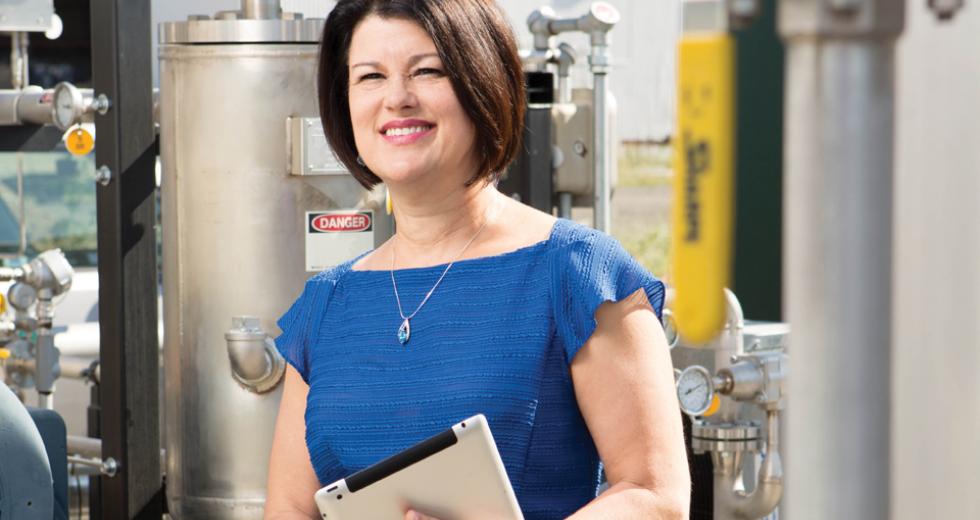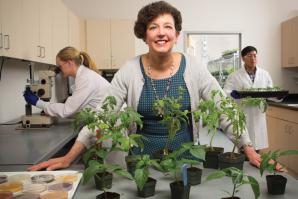Michele Wong, 54, is the CEO of Synergex and the president and CEO of CleanWorld. Synergex provides products and professional services that help businesses maximize their investments in enterprise applications. CleanWorld, a subsidiary of Synergex, is a leading North American innovator in advanced, high-solids anaerobic digestion technology, a process through which microorganisms break down biodegradable material, producing biogases that can be used as energy. Wong also serves as board president for the Powerhouse Science Center and is the co-chair of the center’s capital campaign.
“In 1982, I was one of four women in the first graduating class of computer science majors at UC Davis. When my daughter graduated from Loyola Marymount in 2010 with an engineering degree, she was one of six women in the class. So things haven’t changed enough. That’s why I have been passionate about the Powerhouse Science Center. It’s really about global competitiveness. We’re not producing enough bright, young people to take on the type of challenges we need to take on.”
“It’s scary to me that we are potentially going to turn into a service-industry country. In order for us to remain strong and competitive, we need to be the innovators. We need to be creating the technologies and the new innovations that are driving the solutions. That is why I got involved in the [Powerhouse Science Center] effort. I want to find ways to encourage interest in the math, science and engineering types of careers — particularly for young women.”
“Throughout my life, I’ve always had an affinity for leadership. Through high school and college, I was always in a leadership position in various programs, clubs, groups and committees. So when one of [Synergex’s] co-founders suddenly and unexpectedly passed away, I volunteered to take over the management of a new product development project. At the time, I was 24 years old and had been on the job for two months. I said, ‘I think I can do this.’”
“As the project moved forward, it became apparent that I needed to expand the team. To free up the software developers to do just that, I was given permission to hire product support and technical documentation staff. Before you knew it, I had started building this organization (Digital Information Systems Corp.) that would become Synergex. It’s not as though I progressed rapidly up through the organization; it was more like I developed it underneath me.”
“Synergex now has customers in 80 countries. About 25 to 30 percent of our annual sales come from outside the U.S. Through the ’70s, ’80s and even the ’90s, the software development industry was on a really high growth curve. Synergex and our customer base successfully rode this trend. Since the early 2000s, this growth curve has leveled out. It’s a profitable, mature business, but we do more updating and training than we do software development.”
“So we started to look for opportunities to diversify our revenue mix. In 2010, we launched Synergex Ventures as a subsidiary, with the intention of looking at opportunities in the clean tech sector. Because of the UC Davis spinoffs and technology centers being developed in the area, we could see there were people with great technical ideas but not necessarily the experience or resources to commercialize the technology and get it to market. We were confident we could bring to the table both product development experience and seed capital.”
“In January 2011, we took a majority position in CleanWorld. At the time, the founders had just procured a license from UC Davis for the anaerobic digestion technology developed by Dr. Ruihong Zhang. By the end of the year, we turned that patented technology into a completely developed commercial product and had broken ground on the first commercial anaerobic digestion facility in Sacramento.”
“The digester method has been around for a long time. (It works by allowing microorganisms to break down biodegradable waste. The byproduct is biogases that can be used as energy.) There are lots of digesters in Europe. The reason it worked earlier in Europe than the U.S. has to do with costs. In Europe, the tipping fees (the charge for dropping material into landfills) are much higher than here. Additionally, the cost of our electricity is much lower than in Europe. On both sides of the equation they were offsetting much higher costs. For years, the price tag for organic digesters for solid and sewer waste was much too high in the U.S. to justify the investment.”
“When we took a look at Dr. Zhang’s design, we became intrigued with the potential low capital cost for developing her technology. We were able to design all the mechanical and electrical components as well as the control systems. All of the engineering has been done using standard off-the-shelf components. This allows the majority of the work to be done in a manufacturing facility where you’re using shop labor instead of field labor. This approach has reduced capital costs by about two-thirds.”
“The digesters operating in the U.S. are very large-scale systems. In order to make them pencil out, they were collecting waste from a pretty large circumference area. We can create a cost-effective system that processes 25 to 50 tons a day, like the one at UC Davis that is located close to the source of the waste and also close to the use of the biogas. Depending on the size of the facility, typically our digesters will only be using 10 to 20 percent of the energy being produced for operating the facility itself.”
“CleanWorld was actually profitable last year. It’s not cash flow positive yet because we’re putting so much money into the projects themselves. We’re actually raising money right now from investors for the purpose of taking this deal on the road. We financed, own and operate those three projects. We went out on a limb to prove the technology was effective, efficient and sustainable. Now it’s time for that risk to pay off.”
“The next step of our business model is to be a technology provider and support the technology. We will not be building, financing, owning and operating future facilities. We’re working with developers from all over the country and some from outside the U.S. who want to develop digesters alongside their projects. We’ll help them design the facilities, provide installation technology and then consult on an ongoing basis.”
“Our vision with Synergex Ventures is to be able to take something like CleanWorld from the bench scale and get it to commercialization. With our expertise and financing, we create momentum and market acceptance. After that, the company becomes an independent entity. It either gets bought out by a major corporation or goes public.”
“If CleanWorld is purchased at some point, it’s not likely they would move the company outside of the region. California has a 75-percent landfill diversion goal by the year 2020. For that to actually occur, California is going to need 150 new digesters by 2020. We have three operating facilities in this state. Nobody else does. We have great relationships here and influence. The fact that we’re in Sacramento is one of the attractive aspects of the company.”
“We never intended for our first deal to suck us in as much as CleanWorld has. We thought we would make a small investment, provide some resources and then sit by and watch it blossom. But it quickly became apparent it was an amazing opportunity at a great time. We invested millions of dollars as well as staff time. Because of this effort, we just didn’t have any bandwidth to pursue other opportunities. Once we’re confident CleanWorld is getting sufficient market attention, we will be looking to expand our portfolio of companies.”
Douglas Curley is the editor in chief of Comstock’s. Contact him at dcurley@comstocksmag.com.
Recommended For You

Clean-Tech’s New Frontier
The green rush is over. Now what?
For much of the past decade, venture capitalists showered dollars upon clean-technology startups with promising-sounding ideas in areas like solar, electric cars and biofuels.
That era appears to have ended.




